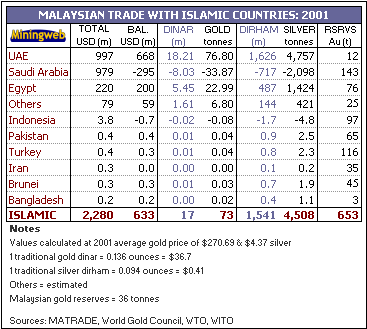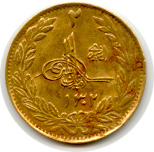NEW YORK -- Malaysia has unveiled additional information about its
ponderous Islamic dinar project, setting a date of 2003 to commence
bilateral trade in the gold-backed currency. Nor Mohamed Yakcop, economic
adviser to Malaysia’s semi-permanent Prime Minister, Mahathir Mohamad,
gave the news at a trade conference in Kuala Lumpur.
Malaysia has had a bee in its bonnet about Western complicity for the
Asian meltdown of 1997-8. Thailand was the first domino to fall when
the value of the baht was shattered and contagion spread throughout
the region, inflamed by high risk lending practises.
Mahathir has since sought to lock up Malaysia’s capital markets and
insulate the country from the globalisation process – even as it seeks
to ramp up the exports that drive the economy. The gold dinar is seen
as a way to further reduce dependence on the Western finance-treasury
complex after the ringgit was pegged at 3.8 to the dollar in September
1998 and the government tried to force hedge funds to be more transparent.
Nor Mohamed told reporters that Malaysia was proposing to use the gold
dinar to settle bilateral trade with other Islamic states, hoping to
build it into a multilateral arrangement in time. A quarterly exchange
of bullion would settle trade balances, with day-to-day trade denominated
in an electronic form of the dinar.
The dinar project has taken on added significance since 9/11 with some
Islamic countries seeing it as a firewall against “an inherently unstable
and ultimately unjust global monetary system”, according to Nor Mohamed.
The Koran has explicit injunctions against usury of any form and prohibits
“infidels” managing “Muslim” money. Similarly partnerships with non-Muslims
outside Islamic judicial areas is discouraged.
These prescriptions and prohibitions collapsed completely once petrodollar
wealth flooded into Islamic states, where the beneficiaries soon repatriated
it to the Western metropoles in order to earn a return.
Dinar history
The history of the gold dinar is traced to the second Caliph, Umar
(632 AD), when a bimetallic standard was set of 1.43 silver dirhams
for every 1 gold dinars. The oldest dated coins come from the third
Caliph, Uthman (644 AD), who compiled the Koran as we know it today,
but was murdered by rivals for rejecting the prophecies of Muhammad,
and ultimately sowed the seeds for the subsequent split between Shiites
and Sunnis. After 695 AD Caliph Abdalmalik, famous as Islam’s “first”
chess player, began a systematic expansion of the bimetallic standard
throughout the then rapidly expanding Islamic empire.
According to the World Islamic Trading Organisation, the dinar is equivalent
to 4.3 grams of gold at 916 fineness (22 carat), or 4.22 grams of four
nines gold (0.14 troy ounces). The dirham is equal to 3 grams of Sterling
silver (925 fineness), or 2.9 grams at four nines (0.09oz).
Malaysia is expected to prefer a 1-ounce dinar to eliminate confusion
about the precise value of the currency that is often quoted on commercial
exchanges at 4.25 grams. If the silver dirhim is also introduced, there
is likely to be an exceptional arbitrage market for bullion traders
– which would probably raise the ire of Mahathir even further.
Trade numbers
Malaysia’s trade with exclusively Islamic countries is tiny. Limited
data is available, but using 2001 figures published by Malaysian trade
officials, it is evident that total “Islamic trade” amounts to no more
than 1.4% of the national total of $162 billion, and just 8% of exchanges
with the United States.
In nearly every case, Malaysia has a net trade surplus and the imbalance
is especially acute within the Islamic bloc it is now eyeing. Emirates
and Saudi Arabia are the dominant partners, followed by Egypt and a
clutch of minnows.
Since Malaysia is an aggressive exporter with a near obsession for
accumulating trade surpluses, its Islamic trading partners may not be
too happy at the prospect of leaking bullion to South East Asia. In
2001, the average price of gold at $271 per ounce would have netted
Malaysia over 70 tonnes, or over 60 tonnes at recent prices.
The UAE would have been hard pressed by a dinar trade scheme in 2001,
with gross national gold reserves worth less than two months of Malaysian
import cover, or little more than that at present prices. On the other
hand, Saudi Arabia would likely be only too happy to take a net trade
gain of 30 tonnes or so a year out of Mahathir’s hands, which, based
on passed history, would be rapidly converted back into dollars.
If the scheme is implemented as promised next year, Malaysia would
“tie up” between 230 tonnes (55 million dinars) and 200 tonnes (48 million
dinars) a year at gold prices of $300 and $350 respectively. According
to the latest World Gold Council figures, the Islamic bloc gold reserves
cover liquidity requirements about two and a half times, which does
not inspire great confidence.
Nevertheless, dinar trade would provide a solid pillar for the gold
price, ensuring that an amount equivalent to nearly 10% of annual new
mine production is more or less off limits to speculators, especially
because of the quarterly settlements.

Having your cake and eating it
Dinar trade comes with plenty of strings attached since it is confined
to the official sector; Malaysia has a long way to go before it trusts
its citizens, never mind the West.
The central bank will force local importers and exporters to continue
dealing in ringitt, which undermines the Islamic flavour of the dinar
since the religion forbids the use of fiat currency, which amounts to
the issue of promissory notes. Needless to say, the Islamic world will
never swear off such notes, not matter how filled with zeal some of
the fundamentalists may be.
There is additional dilution by the intention to do the settlement
loco London, although Dubai must be an attractive alternative. However,
political instability in the region means most of the stash will continue
to be held in either London or New York.
If Mahathir really got serious, he might think of putting Malaysia
onto a gold backed unit. Current Malaysian M1, the narrowest definition
of money, would soak up 2,200 tonnes of gold, equivalent to Switzerland’s
entire reserves and 60 times what Malaysia has to its name. Using a
prudent reserve requirement of 15%, a gold backed unit would require
national gold reserves of around 330 tonnes, which stock Malaysia could
build within 5 years if it succeeds in roping in the targeted trade
partners.
That is the sort of impact gold producers would love to see from the
dinar project, which would immediately transfer gold from the central
banking community’s weak hands to the stronger hands.
Risks
The primary risk for Malaysia is ensuring that dinar transaction costs
do not exceed those of the dollar. The settlement frequency suggests
that will be extremely hard to do and countries with low reserve cover
will be hardest hit unless they can source bullion inflows from other
trade partners or on the capital account.
If transaction costs rise, and they would be substantial on the envisaged
tonnages, Malaysia may well see China and Singapore only too happy to
step into the gap, and the trade partners more concerned about a bargain
than Koranic rigidity. After all, state religion has never trumped money,
so Mahathir’s dream of midwifing an Islamic currency is bound to suffer
a miscarriage.
Indeed, if Malaysia’s trade account was in deficit, how keen would
the 22-year president be on the gold dinar?
 THE GOLD DINAR RESEARCH GROUP
THE GOLD DINAR RESEARCH GROUP 